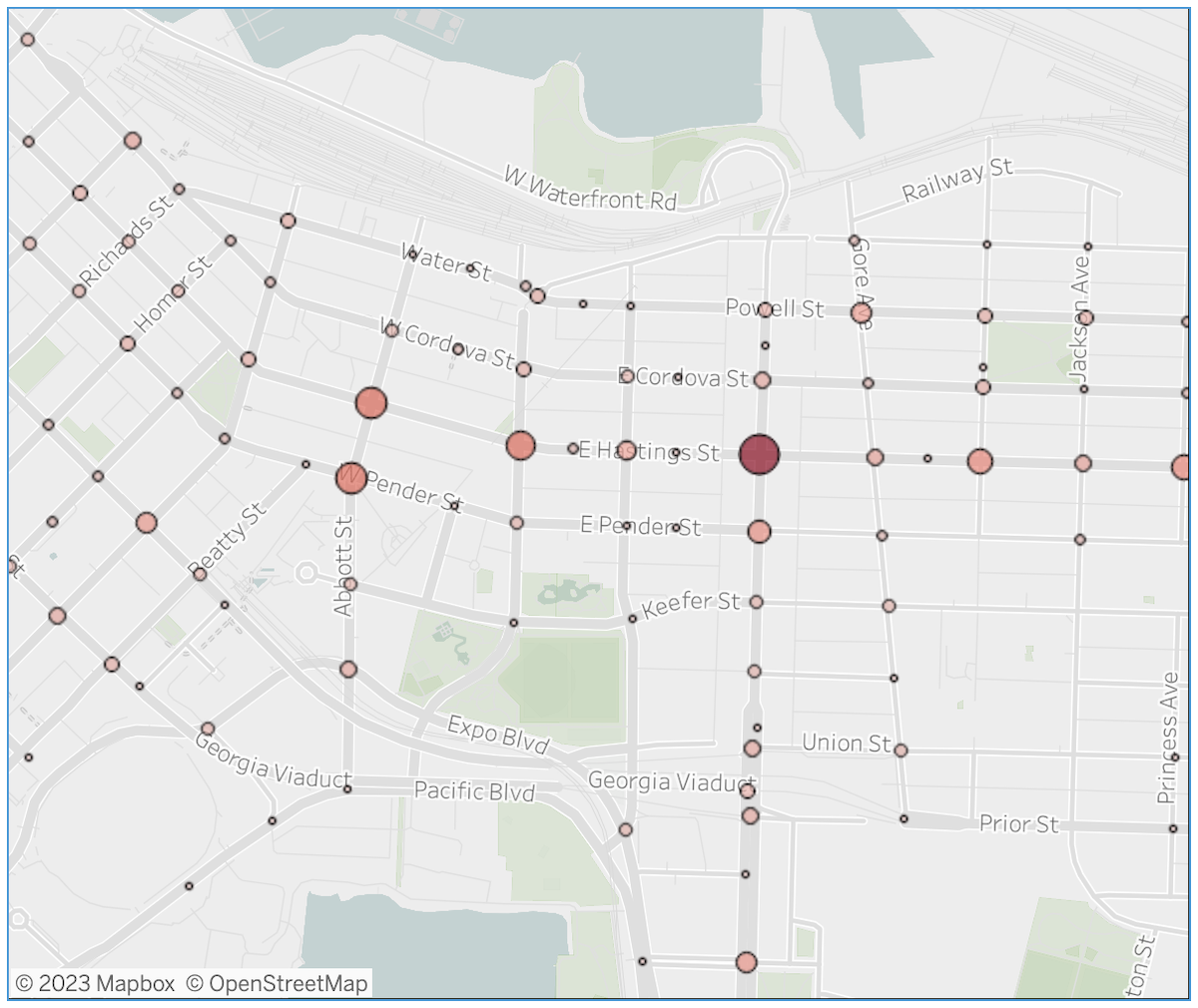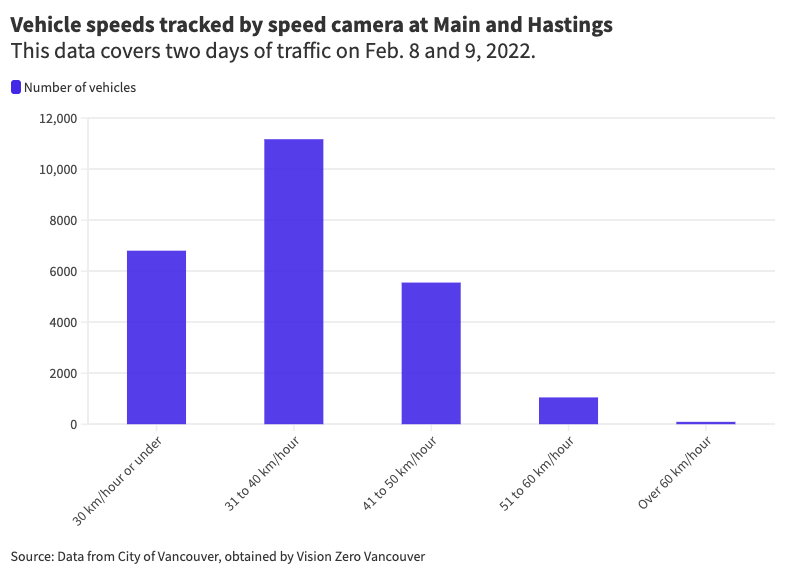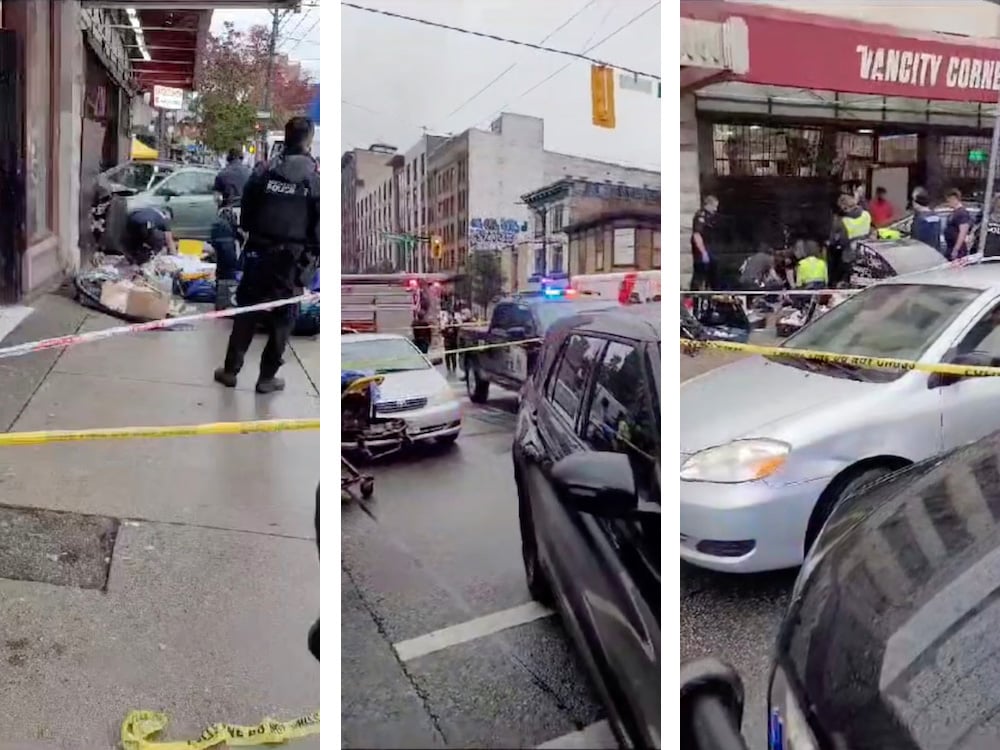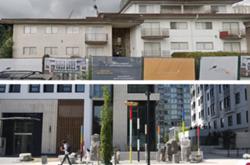In the wake of a collision on East Hastings Street that killed a man on the sidewalk, a road safety group says City of Vancouver data shows that just 28 per cent of drivers are following the posted speed limit on British Columbia’s most dangerous street for pedestrians.
“Unfortunately, one of my reactions was a lack of surprise because it's such a dangerous area,” said Mihai Cirstea, a member of Vision Zero Vancouver, of the collision. “There are incidents every month there.”
In the collision Thursday, a man was on the sidewalk in front of Vancity Corner Store at Hastings and Columbia around 11 a.m. when two cars collided in the intersection. The impact sent one vehicle hurtling across the sidewalk and into the store, hitting the man.
Video from the scene shows first responders performing CPR, but the man did not survive. He was pronounced dead on the street.
Vision Zero is calling for more enforcement of the 30-kilometres-per-hour speed limit that’s in place on the six blocks of East Hastings.
The group also says the street itself needs to be redesigned to make it safer for vulnerable pedestrians.
“You could expand the sidewalks, you could put some separation, you could put more trees, you could put in bollards,” Cirstea listed. “So if the car does get propelled to the sidewalk, it hits a bollard instead of a human being.”
This stretch of East Hastings in the heart of the Downtown Eastside is always full of people. Residents living in poverty use it as a place to eat, sleep, buy and sell necessities, use drugs and visit with neighbours.
It’s also the most dangerous street in the province to be a pedestrian, with a busy six-lane arterial road whipping through a neighbourhood where many residents are struggling with extreme poverty, mental health, addiction and other chronic health issues.
The intersection at Main and Hastings streets has the highest number of pedestrian-car collisions in the province: 55 pedestrians were hit at this intersection between 2018 and 2022, according to Insurance Corp. of British Columbia data. The next worst intersection in the province, Vancouver's Cambie Street and West 49th Avenue, had 26 pedestrian-car collisions in the same period.
Pedestrians are also frequently hit at other Downtown Eastside intersections along Hastings.

The speed limit was lowered to 30 km/h a decade ago to protect vulnerable pedestrians in the neighbourhood. The lower speed limit applies on East Hastings Street for six blocks, between Jackson Avenue and Abbott Street.
But Downtown Eastside resident BeeLee Lee says drivers are routinely speeding through the neighbourhood.
“I drive up and down that street all the time, and everyone speeds through that corridor, including police,” Lee said, who drove by the collision on Thursday and went to the corner store for a pack of gum just an hour before the crash.
Just one day after the collision, Trey Helten, a harm reduction worker, posted another photo showing a semi-trailer in the intersection of Main and Hastings with an ambulance and police officers nearby. “Someone got smoked by 53' trailer this morning,” he wrote. “They lived.”
Police say they are still investigating the Thursday crash and it’s not known what role speed may have played.
Vancouver Police Department spokesperson Steve Addison told The Tyee that officers do perform frequent traffic stops along the corridor, but because many Downtown Eastside residents don’t trust police, “we’ve found that the presence of an officer with a radar camera often leads to conflicts in the community.”
“Without the benefit of radar, our officers are trained to follow a vehicle in order to measure its speeds, and more often than not an officer will simply follow a vehicle to a safer, more controlled location before choosing to do a traffic stop.”
Data from the City of Vancouver shows a minority of drivers are obeying the 30 km/h speed limit, and that can make a life-or-death difference when a driver hits a pedestrian.
Vision Zero Vancouver, an advocacy group calling on governments to commit to reduce the number of traffic crashes resulting in death and serious injury to zero, obtained the data from a speed camera at Main and Hastings.
The data for two days in February 2022 shows that just 32.4 per cent of drivers were going 30 km/h or slower, while 45 per cent were driving 31 to 40 km/h and 22 per cent were going 41 to 50 km/h. Around five per cent of drivers were going 51 to 60 km/h, while 0.3 per cent, or 83 drivers, sped through the intersection at 61 to 70 km/h. Ten drivers were recorded driving faster than 70 km/h.

Addison said police used the speed camera to issue 1,200 tickets in the 30 km/h zone between January and October 2022. But Cirstea said the number falls far short of the 6,697 drivers clocked at driving over 40 km/h in the 30 km/h zone in just two days of the year in 2022.
Vision Zero has now teamed up with Coun. Christine Boyle to introduce a motion at next week’s city council meeting. The motion proposes installing speed and red-light cameras at all 151 of Vancouver’s “most dangerous” intersections, chosen because those intersections had over 100 crashes causing injury or death between 2018 and 2022, or 50 crashes if the intersection is near a school. Currently only 44 of those dangerous intersections have cameras installed.
Slowing down is important for pedestrian safety, Cirstea explained, because drivers travelling 30 km/h are less likely to hit a pedestrian. If a car does hit a pedestrian at 30 km/h, the person has a 90 per cent chance of surviving the collision. If a pedestrian is hit at 50 km/h, the person has an 80 per cent chance of being killed.
High speeds also increase the risk of a car being propelled onto the sidewalk, Cirstea said.
More enforcement of the speed limit is one of the quickest ways to make the street safer. But Cirstea said the six-lane arterial road — a key connector between downtown Vancouver and East Vancouver and Burnaby — won’t be safe for pedestrians until it’s redesigned to actually slow down drivers.
“They reduced the speed limit, but all the visual cues on that road for a driver say drive fast,” Cirstea said.
For instance, Cirstea said, multiple lanes give drivers the leeway to pass slower cars, while the road itself resembles a highway.
Then there’s the terrible combination of a wide arterial road with the impoverished Downtown Eastside neighbourhood. Some pedestrians are unaware of their surroundings for a variety of reasons: they could be suffering from an episode of psychosis or be under the influence of drugs or alcohol.
Because many residents are homeless or live in very poor housing, the sidewalks are often packed, sometimes leading pedestrians to walk in the road to get past tents or other obstacles.
In response to questions about the collision Thursday and improving pedestrian safety on Hastings, the Vancouver Police Department told CTV News that most pedestrian-vehicle collisions in the Downtown Eastside are caused by “pedestrians walking into the roadway when vehicles have the right-of-way.”
Vision Zero Vancouver says that messaging is disappointing, especially because the collision last week apparently involved a pedestrian who was hit when he was walking on the sidewalk.
Addison told The Tyee that the VPD’s message continues to be that everyone — pedestrians, cyclists and drivers — has a role to play in road safety.
“Drivers need to obey the speed limit,” Addison said. “Pedestrians need to cross the street at marked crosswalks, or from corner to corner if there is no crosswalk. Cyclists should be aware of bylaws, stay off the sidewalks and ride with the flow of traffic.”
Lee said she often observes police cars without lights and sirens on that appear to be going faster than the 30 km/h speed limit. In September, Vancouver police officer Jack Zhao was charged with speeding and two other motor vehicle offences, nearly a year after Zhao hit and seriously injured Dennis Hunter near Main and Hastings.
The Downtown Eastside is a heavily policed neighbourhood and officers frequently accompany city workers to help clear the sidewalks of homeless people’s belongings, a practice known as “street sweeps.”
Lee would like to see police resources redeployed to enforce traffic laws.
“They should do their job, and do some education and enforcement on drivers who speed through the neighbourhood,” Lee said.
* Story updated on Oct. 25 at 11:09 a.m. to correct the time period of the speed camera data collected by the City of Vancouver and obtained by Vision Zero Vancouver. ![]()
Read more: Rights + Justice, Transportation, Urban Planning

















Tyee Commenting Guidelines
Comments that violate guidelines risk being deleted, and violations may result in a temporary or permanent user ban. Maintain the spirit of good conversation to stay in the discussion and be patient with moderators. Comments are reviewed regularly but not in real time.
Do:
Do not: